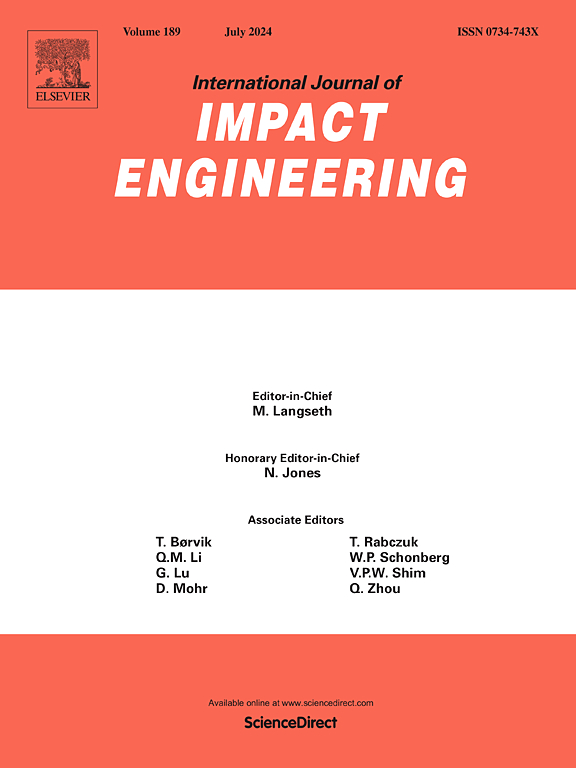Collision of circular/elliptic rings and spheroid shells with a rigid surface
IF 5.1
2区 工程技术
Q1 ENGINEERING, MECHANICAL
International Journal of Impact Engineering
Pub Date : 2025-06-24
DOI:10.1016/j.ijimpeng.2025.105452
引用次数: 0
Abstract
Тhe moving free-body impact occurs in various engineering applications ranging from sports ball's rebound from ground and collision of granular materials to cars’ crashing on solid barriers. In those situations, impact duration, energy transformation and energy absorption, rebound behaviour and thereafter coefficient of restitution are the most important characteristics in concern. The dynamic responses of rings with circular and elliptic shapes and shells with spherical and ellipsoidal shapes colliding with a rigid target are studied to clarify the influence of their shapes on the coefficient of restitution (). The structures are made of elastic-plastic materials with the properties referring to Aluminium alloy 6061-T6 and Nylon. The rings with different shapes and spheroid shells with different shapes have equal masses, respectively. An energy partitioning analysis is employed as a tool to explain the variation of the when colliding velocities up to 40 m/s are applied to the rings and colliding velocities up to 25 m/s are applied to the shells. Because of the flexibility of the analyzed structures, attention is paid to the effects of the structural vibrations and elasticity. Distinct differences between the dynamic responses of the rings and spheroid shells are observed caused by their different flexibility.
It is established that the coefficient of restitution of the analyzed structures is mainly governed by the translational motion. The shapes and material properties of both the rings and shells significantly influence their coefficient of restitution. The of the rings in the elastic range is greatly reduced by their vibrational motion when the largest is observed in the circular ring while the smallest one is detected for the ring in a vertical ellipse shape. The spheroid shells have coefficients of restitution close to one in the elastic range due to the negligible elastic vibrations. In the elastic-plastic range, the of the rings is strongly influenced by the deformation history due to their large global deformation. The of the shells with different shapes are influenced mainly by the local deformations in the contact area where the largest is observed in the oblate spheroid shell while the smallest one is observed in the prolate spheroid shell within the entire range of the analyzed impact velocities. The parametric analysis is conducted by using FE simulations facilitated by Abaqus/Explicit.

圆/椭圆环和球壳与刚性表面的碰撞
Тhe移动的自由体碰撞发生在各种工程应用中,从体育球从地面反弹和颗粒材料的碰撞到汽车在固体障碍物上的碰撞。在这种情况下,冲击持续时间、能量转换和能量吸收、回弹行为和随后的恢复系数是最重要的特征。研究了圆形环和椭圆形环以及球形和椭球形壳与刚性目标碰撞时的动力响应,以阐明其形状对恢复系数的影响。结构采用弹塑性材料,其性能参考铝合金6061-T6和尼龙。不同形状的环和不同形状的球壳质量相等。能量分配分析作为一种工具来解释当碰撞速度高达40 m/s时,环和碰撞速度高达25 m/s时,壳的CoR的变化。由于所分析的结构具有柔性,因此要注意结构振动和弹性的影响。由于环和球壳的柔度不同,导致环和球壳的动力响应存在明显差异。结果表明,所分析结构的恢复系数主要受平移运动的影响。环和壳的形状和材料特性对其恢复系数有显著影响。当环形环的弹性系数最大,而垂直椭圆形环的弹性系数最小时,环的振动运动使环的弹性系数大大减小。由于弹性振动可以忽略不计,球壳在弹性范围内的恢复系数接近于1。在弹塑性范围内,由于环的整体变形较大,环芯的变形量受变形历史的影响较大。不同形状壳体的CoRs主要受接触区域局部变形的影响,在整个分析的冲击速度范围内,扁球壳的CoRs最大,而长形球壳的CoRs最小。参数分析采用Abaqus/Explicit有限元模拟软件进行。
本文章由计算机程序翻译,如有差异,请以英文原文为准。
求助全文
约1分钟内获得全文
求助全文
来源期刊

International Journal of Impact Engineering
工程技术-工程:机械
CiteScore
8.70
自引率
13.70%
发文量
241
审稿时长
52 days
期刊介绍:
The International Journal of Impact Engineering, established in 1983 publishes original research findings related to the response of structures, components and materials subjected to impact, blast and high-rate loading. Areas relevant to the journal encompass the following general topics and those associated with them:
-Behaviour and failure of structures and materials under impact and blast loading
-Systems for protection and absorption of impact and blast loading
-Terminal ballistics
-Dynamic behaviour and failure of materials including plasticity and fracture
-Stress waves
-Structural crashworthiness
-High-rate mechanical and forming processes
-Impact, blast and high-rate loading/measurement techniques and their applications
 求助内容:
求助内容: 应助结果提醒方式:
应助结果提醒方式:


